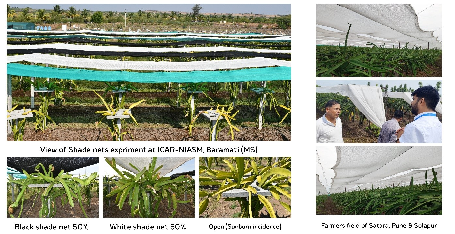Dragon fruit (Selenicereus spp.) has emerged as a high-value horticultural crop across semi-arid and hot-humid regions of Maharashtra, Gujarat, Karnataka, Tamil Nadu, Andhra Pradesh, Telangana, and West Bengal. However, its cultivation is increasingly constrained by sunburn injury during peak summer months when temperatures often exceed 35 °C. Due to its Crassulacean Acid Metabolism (CAM) physiology, dragon fruit closes its stomata during the daytime, limiting evaporative cooling. This makes the crop highly susceptible to heat stress and solar radiation, resulting in yellowing of cladodes, stem rot, chlorophyll depletion, increased disease susceptibility, and reduced vegetative and reproductive growth—ultimately compromising yield and fruit quality.
Challenges in Existing Practices
Farmers have traditionally relied on inadequate methods, such as leaving plants untreated, reducing irrigation, using 50% green shade nets, or applying foliar sprays of kaolin (5–10%). While kaolin reflects some solar radiation, it does not create a conducive microclimate for plant growth, leaving crops vulnerable to heat stress.
Innovative Intervention by ICAR–NIASM
To address these challenges, ICAR–National Institute of Abiotic Stress Management (NIASM), Baramati, Pune, developed an artificial shading technology during 2022–2023. Comparative evaluation demonstrated that black and white shade nets (50% intensity) were more effective than green nets. The recommended installation involves RCC poles or metal angles (8–10 m height) fitted with 2 m “T” bars at 10 m intervals, with 2 m-wide shade nets positioned 0.75 m above the canopy during April–May and removed with the onset of the monsoon. Installation costs range from ₹1.0–1.5 lakh per acre.

Key Benefits
- The adoption of black and white 50% shade nets produced significant agronomic advantages:
- Reduced canopy temperature by 5–6 °C and incident light by ~50%, lowering sunburn incidence by >90% and disease occurrence by 30–40%.
- Preserved chlorophyll content, sustaining photosynthesis under heat stress.
- Advanced flowering by ~15 days, increased fruitful cladodes, flower bud formation, fruit set, and reduced bud drop.
- Enhanced yield by 40–70%, translating to 5.5–8.0 tonnes per hectare.
- Lower input costs, with reduced pesticide application, resulting in improved benefit-cost ratios of 2.00 (black net) and 2.30 (white net).
On-Farm Demonstration and Impact
The technology was successfully demonstrated in major dragon fruit–growing districts of Maharashtra—Pune, Satara, Sangli, and Solapur—across 10 farmers’ fields. Farmers reported:
- Advanced flowering by 12–15 days
- 20–30% improvement in fruit set and 1–2 additional fruit flushes
- Yield increases of 5–6 tonnes per hectare (≈30% higher than conventional practice)
- Nearly 25% reduction in pesticide use
- Net income increase of ₹2–3 lakh per hectare
The artificial shading technology for dragon fruit is a climate-resilient, high-return innovation that mitigates sunburn, improves productivity, enhances fruit quality, and increases profitability. By creating a protective microclimate, this approach empowers farmers to maximize returns while promoting sustainable horticultural practices in semi-arid and hot-humid regions.
(Source: ICAR-National Institute of Abiotic Stress Management, Baramati, Pune)







फेसबुक पर लाइक करें
यूट्यूब पर सदस्यता लें
X पर फॉलो करना X
इंस्टाग्राम पर लाइक करें